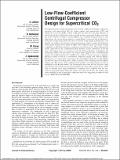Low-Flow-Coefficient Centrifugal Compressor Design for Supercritical CO₂
Author(s)
Casey, M.; Spakovszky, Z.; Lettieri, Claudio; Baltadjiev, Nikola Dimitrov
Downloadturbo_136_08_081008.pdf (2.065Mb)
PUBLISHER_POLICY
Publisher Policy
Article is made available in accordance with the publisher's policy and may be subject to US copyright law. Please refer to the publisher's site for terms of use.
Terms of use
Metadata
Show full item recordAbstract
This paper presents a design strategy for very low flow coefficient multistage compressors operating with supercritical CO₂ for carbon capture and sequestration (CCS) and enhanced oil recovery (EOR). At flow coefficients less than 0.01, the stage efficiency is much reduced due to dissipation in the gas-path and more prominent leakage and windage losses. Instead of using a vaneless diffuser as is standard design practice in such applications, the current design employs a vaned diffuser to decrease the meridional velocity and to widen the gas path. The aim is to achieve a step change in performance. The impeller exit width is increased in a systematic parameter study to explore the limitations of this design strategy and to define the upper limit in efficiency gain. The design strategy is applied to a full-scale reinjection compressor currently in service. Three-dimensional, steady, supercritical CO₂ computational fluid dynamics (CFD) simulations of the full stage with leakage flows are carried out with the National Institute of Standards and Technology (NIST) real gas model. The design study suggests that a nondimensional impeller exit width parameter b₂* =(b₂ /R)φ of six yields a 3.5 point increase in adiabatic efficiency relative to that of a conventional compressor design with vaneless diffuser. Furthermore, it is shown that in such stages the vaned diffuser limits the overall stability and that the onset of rotating stall is likely caused by vortex shedding near the diffuser leading edge. The inverse of the nondimensional impeller exit width parameter b₂* can be interpreted as the Rossby number. The investigation shows that, for very low flow coefficient designs, the Coriolis accelerations dominate the relative flow accelerations, which leads to inverted swirl angle distributions at impeller exit. Combined with the twoorders- of-magnitude higher Reynolds number for supercritical CO₂ , the leading edge vortex shedding occurs at lower flow coefficients than in air suggesting an improved stall margin.
Date issued
2014-01Department
Massachusetts Institute of Technology. Department of Aeronautics and AstronauticsJournal
Journal of Turbomachinery
Publisher
ASME International
Citation
Lettieri, C. et al. “Low-Flow-Coefficient Centrifugal Compressor Design for Supercritical CO₂.” Journal of Turbomachinery 136, 8 (January 2014): 081008 © 2014 ASME
Version: Final published version
ISSN
0889-504X